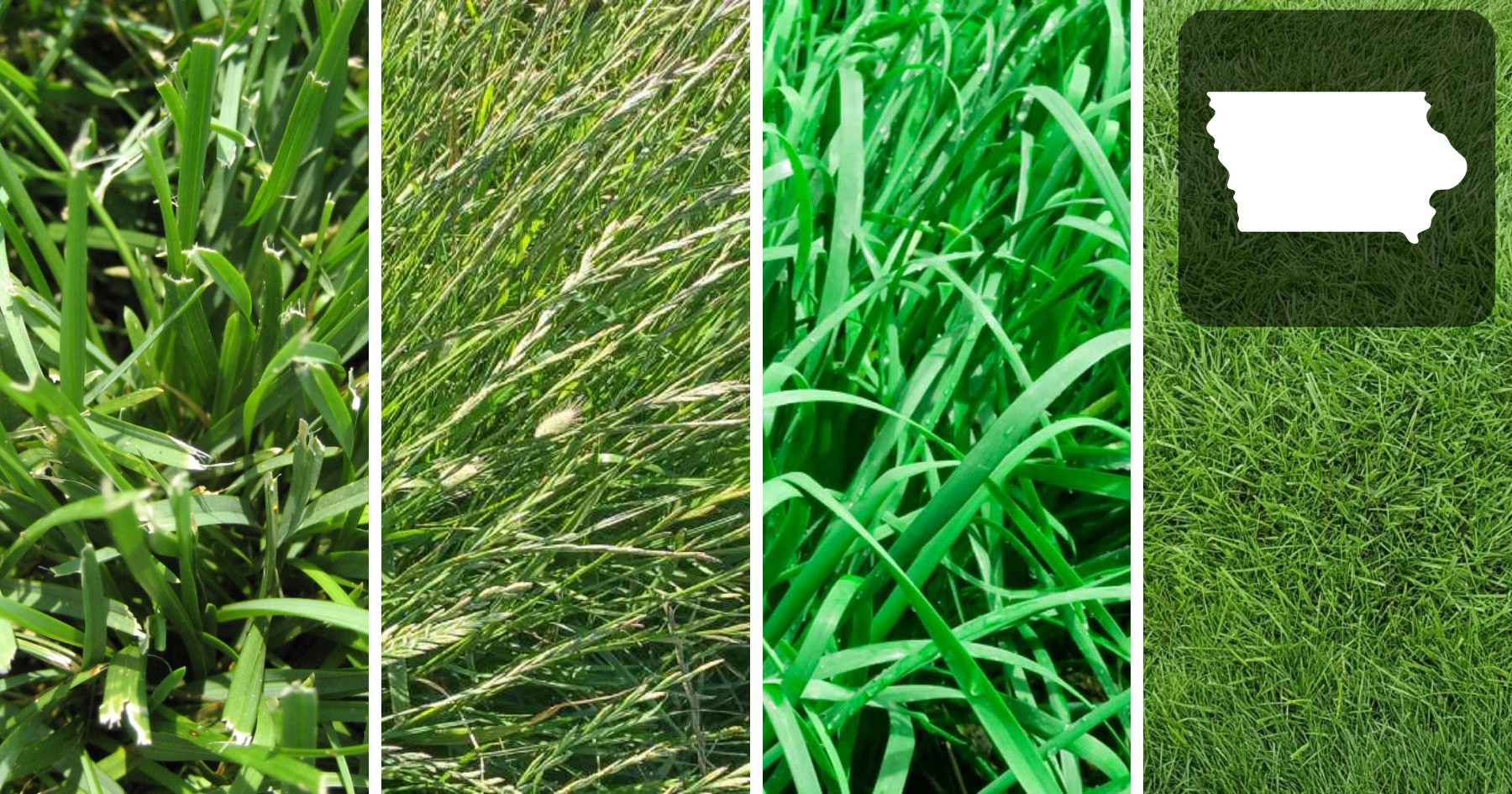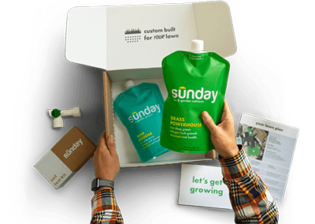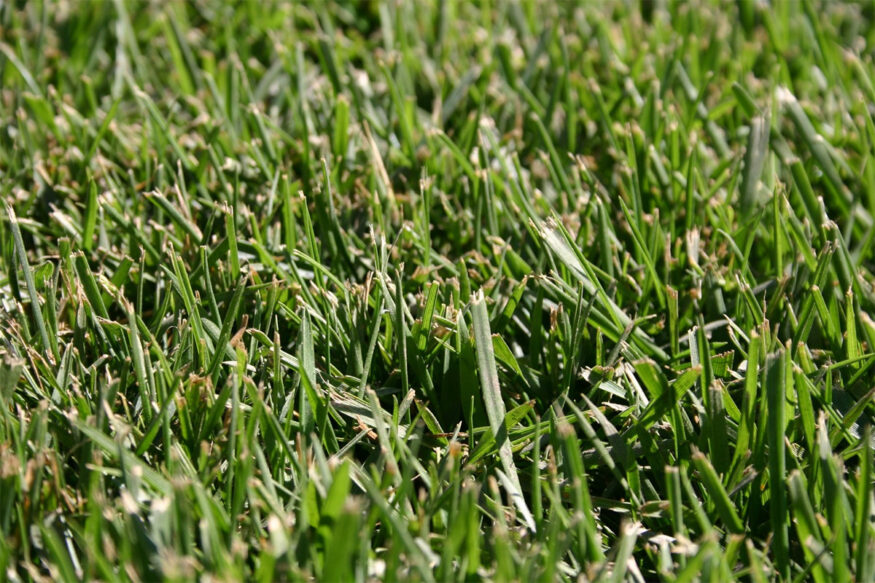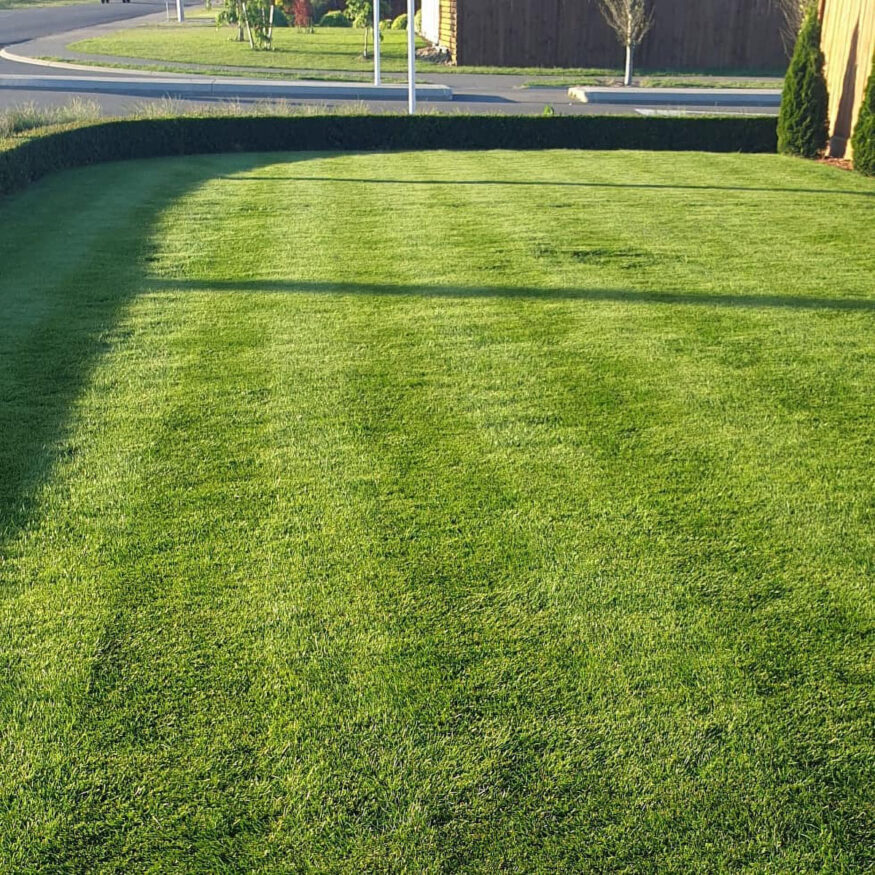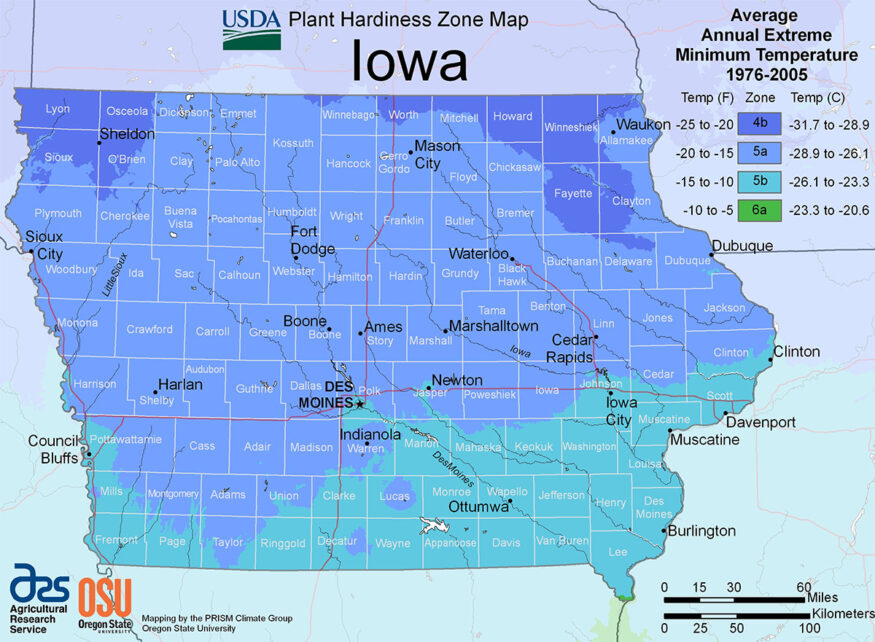Looking to transform your Iowa lawn into a lush, green paradise? We’ve got you covered! Kentucky Bluegrass is a top choice for Iowans seeking the perfect seed. But don’t just take our word for it; read on to learn all about why this grass seed is ideal for Iowa and explore other fantastic options to consider.
Growing a beautiful lawn in Iowa can be challenging due to varying climate, soil conditions, and potential pests. But fear not! We’ve got expert tips and seed suggestions to help you achieve that stunning lawn you’ve always dreamed of.
So, let’s dive in and explore the best grass seed for Iowa!
[ez-toc]
Kentucky Bluegrass
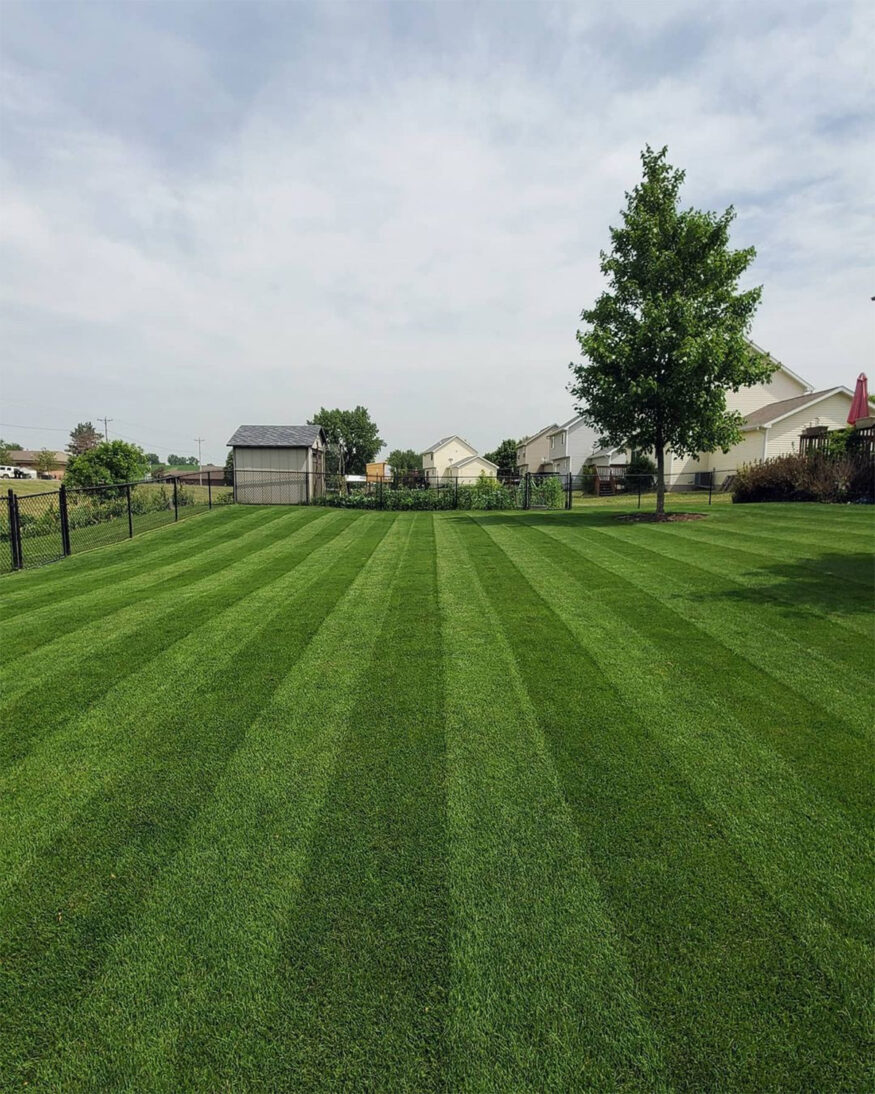 Source: ryanknorrlawncare on Instagram
PIN IT
Source: ryanknorrlawncare on Instagram
PIN IT
| Also Known As | Poa pratensis L. |
| Type of Grass | Cool season perennial |
| Optimal Zones | Northern cool season zone, transition zones |
| Root Structure | Shallow |
| Winter Hardiness | Excellent |
| Shade Tolerance | Poor to Good |
| Water Requirements | High |
| Drought Tolerance | Poor |
| Self Repair Capacity | Excellent |
| Overall Maintenance Requirements | High |
Why Kentucky Bluegrass is The Most Popular Choice For Iowa
If you’re a homeowner in Iowa searching for the ideal grass type for your lawn, then Kentucky Bluegrass should be near the top of your list. This cool-season perennial grass is a popular choice in Iowa due to its drought tolerance and adaptability to various soil types (except heavily clay-based soils with poor drainage). Its stunning dark-green color and fine texture create an eye-catching, soft lawn that will make your neighbors envious.
One reason Kentucky Bluegrass is perfect for Iowa lawns is its rapid recovery from damage caused by foot traffic, pests, or diseases, thanks to its robust underground stems known as rhizomes. Additionally, this grass variety can withstand cold winters and moderate shade better than others, making it a resilient option for your lawn.
When it comes to planting Kentucky Bluegrass in Iowa, late summer or early fall is the ideal time. Ensuring your soil is at the correct pH (between 6.2 and 7.0) and properly aerated will help your grass establish strong roots. To plant, evenly spread seed at a rate of 2 to 3 pounds per 1000 square feet, and water daily until germination occurs, typically within 10 to 21 days.
Once established, maintaining your Kentucky Bluegrass lawn is simple. Mow when it reaches 2 to 3 inches in height and fertilize with a balanced fertilizer four times a year. For an even more luxurious lawn, overseed annually or biennially in the fall using a compatible seed mixture containing other cool-season grasses like perennial ryegrass or fine fescue.
While it may require a bit more water, fertilizer, and mowing compared to some other grasses, Kentucky Bluegrass is an excellent choice for Iowa homeowners seeking a beautiful and sturdy lawn. Keep in mind that it may not be the best option for heavily shaded or poorly drained areas and may be susceptible to specific pests and diseases if not adequately cared for.
Overall, Kentucky Bluegrass provides a lush, green lawn that’s worth the effort, making your Iowa yard a picturesque masterpiece.
Looking for the best grass seed for your region?
Our smart lawn plans are designed to work perfectly with your local soil and climate conditions, without any of the toxic stuff.
Use the code EHG20 for an instant $20 discount!
- Personalized lawn care: Custom lawn plans based on soil analysis, climate data, and your specific lawn needs.
- Convenience with a conscience: Products that are not only easy to use but also safe for you, your pets, and the planet.
- Science-backed formulas: Bio-based formulas contain effective, natural ingredients like seaweed, molasses, and iron.
- Expert support: Get one-on-one guidance from a real person and rest easy with Sunday's satisfaction guarantee.
Perennial Ryegrass
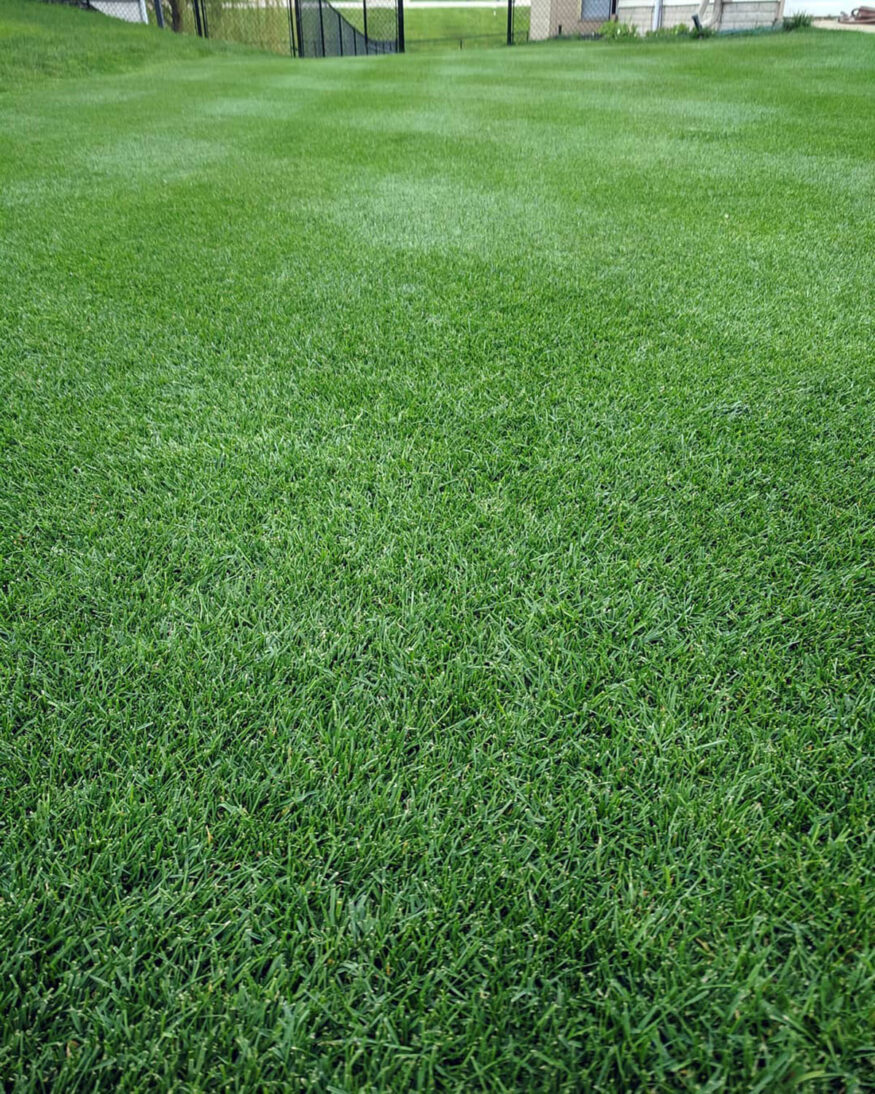 Source: ryanknorrlawncare on Instagram
PIN IT
Source: ryanknorrlawncare on Instagram
PIN IT
| Also Known As | Lolium perenne L. |
| Type of Grass | Cool season perennial |
| Optimal Zones | Mild northern zones |
| Root Structure | Deep |
| Winter Hardiness | Good to excellent |
| Shade Tolerance | Moderate |
| Water Requirements | High |
| Drought Tolerance | Good |
| Self Repair Capacity | Excellent wear tolerance |
| Overall Maintenance Requirements | Moderate to high |
What Makes Perennial Ryegrass is A Great Grass For Iowa
Iowa homeowners looking for the perfect grass seed should also consider perennial ryegrass. This cool-season perennial grass is well-suited to Iowa’s climate, known for its fine texture and dark green color that enhances any home landscape. One of its advantages is its quick germination and establishment, as well as its ability to tolerate moderate shade and foot traffic.
Perennial ryegrass pairs well with Kentucky bluegrass, another popular grass seed choice in Iowa. Combining these two grass seeds results in a dense, durable, and resilient lawn capable of withstanding various weather conditions and stresses. However, be prepared for more frequent mowing, as perennial ryegrass grows quickly.
To maintain a healthy lawn, mow your perennial ryegrass at a height of 2 to 3 inches, water deeply but infrequently, and fertilize with a balanced 10-10-10 fertilizer four times a year. Aerate your lawn once a year in the fall, and if the thatch layer exceeds half an inch in thickness, dethatch your lawn. For weed control, apply pre-emergent herbicides in the spring before weeds germinate, or post-emergent herbicides when weeds are actively growing.
Keep in mind, perennial ryegrass may not perform well in extreme heat, drought, or cold and may not be as durable or wear-resistant as tall fescue or Kentucky bluegrass. Nevertheless, its quick germination, pleasing aesthetic, and ability to blend with other grasses make it a top choice for many Iowa homeowners.
Tall fescue
| Also Known As | Lolium arundinaceum (formerly Festuca arundinacea) |
| Type of Grass | Cool season perennial |
| Optimal Zones | Northern through transition zones |
| Root Structure | Deep |
| Winter Hardiness | Excellent |
| Shade Tolerance | High |
| Water Requirements | Medium to High |
| Drought Tolerance | Excellent |
| Self Repair Capacity | Limited |
| Overall Maintenance Requirements | Low |
Why Tall Fescue Grows is a Good Choice
Iowa homeowners know that finding the right grass for their lawns can be challenging, especially with the state’s hot summers and varying soil conditions. Enter tall fescue, a cool-season perennial grass that’s not only drought-tolerant but also thrives in hot, dry areas and partial shade. While it does require some sunlight, tall fescue is a reliable option for lawns with tree cover or shady hillsides.
Tall fescue’s deep root system sets it apart, making it resistant to diseases, insects, and able to handle dry spells. To keep your tall fescue lawn looking lush, mow every two weeks during summer and fertilize twice a month with a slow-release lawn fertilizer.
In Iowa, the best times to plant tall fescue are late summer/early fall (mid-August to mid-September) or spring (March to mid-June). For a more diverse and resilient lawn, consider mixing tall fescue with Kentucky bluegrass or perennial ryegrass.
However, tall fescue does have its drawbacks. It struggles in heavy clay or sandy soils with poor drainage, so ensure your lawn has good drainage for this grass to thrive. Additionally, tall fescue can form clumps or patches that may look unsightly, and its texture may not be as soft or fine as other grass types.
Despite these minor issues, tall fescue remains a top contender for Iowan homeowners seeking a resilient, attractive lawn that can handle the state’s climate. Its adaptability and resistance to drought, diseases, and insects make it a dependable choice for a beautiful and healthy lawn in the Hawkeye State.
Fine Fescue
| Also Known As | Hard fescue, strong creeping red fescue, slender creeping red fescue, sheep fescue, chewings fescue; Festuca L. |
| Type of Grass | Cool season perennial |
| Optimal Zones | Northern zones |
| Root Structure | Medium |
| Winter Hardiness | Excellent |
| Shade Tolerance | Excellent |
| Water Requirements | Medium to High |
| Drought Tolerance | Excellent |
| Self Repair Capacity | Limited |
| Overall Maintenance Requirements | Low |
Why Fine FescueIs a Popular Grass seed Choice
This cool-season perennial grass thrives in Iowa’s climate, tolerating shade, drought, and cold better than many other grasses. Its fine texture and dark green color create an appealing, low-maintenance lawn that can boost your home’s curb appeal.
One of the best features of Fine Fescue is its adaptability. You can mix it with other cool-season grasses, like Kentucky Bluegrass or Perennial Ryegrass, to increase its density and durability. This blend results in a thicker, more resilient lawn that can better handle foot traffic and other stressors.
To plant Fine Fescue, aim for late summer or early fall when the soil temperature is between 50°F and 65°F. This timing allows the seeds to establish themselves before winter arrives. Once your lawn is established, caring for Fine Fescue is relatively simple. Mow it at a height of 2 to 3 inches and water deeply but infrequently to promote strong root growth. Fertilize with a slow-release nitrogen fertilizer in the spring and fall to maintain a healthy lawn.
However, it’s crucial to understand Fine Fescue’s limitations. It’s best suited for shady, cool, and moist areas, so it may struggle in full sun, high traffic, or poorly drained soils. Moreover, Fine Fescue can be susceptible to diseases like brown patch, dollar spot, red thread, and rust if not properly cared for. To maintain its thickness and appearance, overseeding every year or two may be necessary.
Fine Fescue’s beauty, adaptability, and low maintenance make it a top choice for Iowa homeowners looking to enhance their lawns. With a little extra care, you’ll have a lawn that’s the envy of the neighborhood.
Iowa’s Climate And Growing Challenges For Lawns
Iowa experiences a humid continental climate with four distinct seasons. The average annual temperature is 49°F, which ranges from chilly 12°F temperatures in January to hot 86°F temperatures in July.
The state also receives an average annual precipitation of 34 inches, with most of it falling between April and September. Along with frequent thunderstorms, Iowa faces tornadoes, hail, and snowstorms, which can affect lawn care.
Soil Conditions
The soils in Iowa are rich and fertile, derived mainly from glacial deposits and loess. Soil pH varies from 5.5 to 7.5, and textures range from sandy to clayey, with loam being the most common.
Drainage is generally good, but some areas in the north-central and south-central regions have poor drainage, which can impact the growth of grasses.
Soil Compaction
Soil compaction is a challenge for Iowa lawns due to heavy foot traffic or machinery. Compacted soil reduces porosity and water infiltration, leading to poor root growth, reduced nutrient uptake, and increased runoff and erosion.
To combat this, homeowners should aerate their lawns regularly and avoid using heavy equipment on the grass.
Thatch Accumulation
Excessive thatch accumulation is another concern for Iowa lawn owners. Thatch, a layer of dead and living plant material on the soil surface, can prevent water and air from reaching grass roots, create a habitat for pests and diseases, and increase weed invasion. Regular dethatching can help maintain a healthy lawn and prevent these issues.
Weed Infestation
Weeds like crabgrass, dandelion, clover, plantain, and chickweed are common in Iowa lawns. These unwanted plants compete with desired grasses for space, light, water, and nutrients, making it harder for the grass to thrive.
A combination of proper mowing, fertilization, and weed control treatments can help keep weeds at bay.
Pest and Disease Problems
Pests such as white grubs, sod webworms, chinch bugs, moles, and voles can damage Iowa lawns. Diseases caused by fungi, bacteria, or viruses, including brown patch, dollar spot, red thread, rust, and snow mold, also pose threats to the health of grasses in the area.
Regular lawn inspections, proper lawn care practices, and using pest and disease-resistant grass varieties can help prevent these issues.
Drought Stress
Drought stress can occur when the soil moisture is insufficient to meet the water demand of grasses. This can cause wilting, browning, thinning, and even death of the grasses, making it harder to maintain a healthy, lush lawn in Iowa.
To mitigate drought stress, homeowners should implement water-conserving irrigation practices and choose drought-resistant grass varieties.
Looking for the best grass seed for your region?
Our smart lawn plans are designed to work perfectly with your local soil and climate conditions, without any of the toxic stuff.
Use the code EHG20 for an instant $20 discount!
- Personalized lawn care: Custom lawn plans based on soil analysis, climate data, and your specific lawn needs.
- Convenience with a conscience: Products that are not only easy to use but also safe for you, your pets, and the planet.
- Science-backed formulas: Bio-based formulas contain effective, natural ingredients like seaweed, molasses, and iron.
- Expert support: Get one-on-one guidance from a real person and rest easy with Sunday's satisfaction guarantee.
Frequently Asked Questions
Questions
